Fuzzy Rules to Help Predict Rains and Temperatures in a Brazilian Capital State Based on Data Collected from Satellites
Abstract
Featured Application
Abstract
1. Introduction
2. Literature Review
2.1. Minas Gerais State
2.2. Meteorology
2.3. Weather Forecast
2.4. Extraction and Collection of Meteorological Data
2.5. Artificial Neural Network and Fuzzy Systems
2.6. Intelligent Models Acting in the Prediction of Temperatures and Rains
3. Materials and Methods
Feature of the Database
4. Fuzzy Neural Network for Predicting Rains and Temperatures
4.1. Fuzzy Neural Networks
4.2. First Layer
4.3. Second Layer
- (1)
- Each pair (, ) = = p (, ).
- (2)
- Unified aggregation = U (), where n is the number of inputs.
4.4. Third Layer
4.5. Training Algorithm
5. Meteorological Prediction Test
5.1. Evaluation Criteria
5.2. Models Used in the Test
5.3. Rainfall Prediction Results
5.4. Temperature Prediction Results
5.5. Fuzzy Rules Generated
5.5.1. Temperature Prediction
5.5.2. Rainfall Prediction
6. Conclusions
Author Contributions
Funding
Acknowledgments
Conflicts of Interest
Abbreviations
| MDPI | Multidisciplinary Digital Publishing Institute |
| MG | Minas Gerais |
| FNN | Fuzzy Neural Network |
| UNI | lUnineuron |
References
- Rockström, J.; Barron, J.; Fox, P. Water productivity in rain-fed agriculture: Challenges and opportunities for smallholder farmers in drought-prone tropical agroecosystems. Water Product. Agric. Limits Oppor. Improv. 2003, 85, 1–8. [Google Scholar]
- Pelling, M. The Vulnerability of Cities: Natural Disasters and Social Resilience; Routledge: London, UK, 2012. [Google Scholar]
- Goudie, A.S. Human Impact on the Natural Environment; John Wiley & Sons: New York, NY, USA, 2018. [Google Scholar]
- Nobre, C.A.; Marengo, J.A.; Seluchi, M.E.; Cuartas, L.A.; Alves, L.M. Some characteristics and impacts of the drought and water crisis in Southeastern Brazil during 2014 and 2015. J. Water Resour. Prot. 2016, 8, 252. [Google Scholar] [CrossRef]
- Allison, E.H.; Perry, A.L.; Badjeck, M.C.; Neil Adger, W.; Brown, K.; Conway, D.; Halls, A.S.; Pilling, G.M.; Reynolds, J.D.; Andrew, N.L.; et al. Vulnerability of national economies to the impacts of climate change on fisheries. Fish Fish. 2009, 10, 173–196. [Google Scholar] [CrossRef]
- Atiya, A.F.; El-Shoura, S.M.; Shaheen, S.I.; El-Sherif, M.S. A comparison between neural-network forecasting techniques-case study: River flow forecasting. IEEE Trans. Neural Netw. 1999, 10, 402–409. [Google Scholar] [CrossRef]
- Toth, E.; Brath, A.; Montanari, A. Comparison of short-term rainfall prediction models for real-time flood forecasting. J. Hydrol. 2000, 239, 132–147. [Google Scholar] [CrossRef]
- Jain, A.; Kumar, A.M. Hybrid neural network models for hydrologic time series forecasting. Appl. Soft Comput. 2007, 7, 585–592. [Google Scholar] [CrossRef]
- Zealand, C.M.; Burn, D.H.; Simonovic, S.P. Short term streamflow forecasting using artificial neural networks. J. Hydrol. 1999, 214, 32–48. [Google Scholar] [CrossRef]
- Hsu, K.l.; Gupta, H.V.; Sorooshian, S. Artificial neural network modeling of the rainfall-runoff process. Water Resour. Res. 1995, 31, 2517–2530. [Google Scholar] [CrossRef]
- Nasseri, M.; Asghari, K.; Abedini, M. Optimized scenario for rainfall forecasting using genetic algorithm coupled with artificial neural network. Expert Syst. Appl. 2008, 35, 1415–1421. [Google Scholar] [CrossRef]
- Chang, F.J.; Chen, Y.C. A counterpropagation fuzzy-neural network modeling approach to real time streamflow prediction. J. Hydrol. 2001, 245, 153–164. [Google Scholar] [CrossRef]
- de Campos Souza, P.V.; Torres, L.C.B. Regularized Fuzzy Neural Network Based on Or Neuron for Time Series Forecasting. In Fuzzy Information Processing; Barreto, G.A., Coelho, R., Eds.; Springer International Publishing: Cham, Switzerland, 2018; pp. 13–23. [Google Scholar]
- Alves Diniz, A.M.; Barbosa Batella, W. O Estado de Minas Gerais e suas regiões: Um resgate histórico das principais propostas oficiais de regionalização. Sociedade Natureza 2005, 17, 59–77. [Google Scholar]
- Guilhoto, J. Regional importance of the agribusiness in the Brazilian economy. In Proceedings of the 44th Congress of the European Regional Science Association, Porto, Portugal, 25–29 August 2004. [Google Scholar]
- Neto, L.M.; Forzza, R.C.; Zappi, D. Angiosperm epiphytes as conservation indicators in forest fragments: A case study from southeastern Minas Gerais, Brazil. Biodivers. Conserv. 2009, 18, 3785. [Google Scholar] [CrossRef]
- Viola, M.R.; Mello, C.R.D.; Acerbi, F.W., Jr.; Silva, A.M.D. Hydrologic modeling in the Aiuruoca river basin, Minas Gerais State. Revista Brasileira de Engenharia Agrícola e Ambiental 2009, 13, 581–590. [Google Scholar] [CrossRef]
- Alvarenga, L.A.; Mello, C.R.D.; Colombo, A.; Cuartas, L.A. Hydrologic impacts due to the changes in riparian buffer in a headwater watershed. Cerne 2017, 23, 95–102. [Google Scholar] [CrossRef]
- Pinto, L.C.; Mello, C.R.d.; Ávila, L.F. Water quality indicators in the Mantiqueira Range region, Minas Gerais state. Cerne 2013, 19, 687–692. [Google Scholar] [CrossRef][Green Version]
- Pinto, L.C.; Mello, C.R.d.; Norton, L.D.; Poggere, G.C.; Owens, P.R.; Curi, N. A hydropedological approach to a mountainous Clayey Humic Dystrudept in the Mantiqueira Range, southeastern Brazil. Sci. Agric. 2018, 75, 60–69. [Google Scholar] [CrossRef]
- de Mello, K.; Valente, R.A.; Randhir, T.O.; Vettorazzi, C.A. Impacts of tropical forest cover on water quality in agricultural watersheds in southeastern Brazil. Ecol. Iindic. 2018, 93, 1293–1301. [Google Scholar] [CrossRef]
- Caiaffa, W.T.; Almeida, M.C.d.M.; Oliveira, C.D.L.; Friche, A.A.d.L.; Dias, M.A.S.; Cunha, M.d.C.M.; Pessanha, E.; Proietti, F.A. The urban environment from the health perspective: The case of Belo Horizonte, Minas Gerais, Brazil. Cadernos de Saúde Pública 2005, 21, 958–967. [Google Scholar] [CrossRef]
- Abreu, M.C.; Cecílio, R.A.; Pruski, F.F.; Santos, G.R.d.; Almeida, L.T.d.; Zanetti, S.S. Criteria For Choosing Probability Distributions in Studies of Extreme Precipitation Events. Revista Brasileira de Meteorologia 2018, 33, 601–613. [Google Scholar] [CrossRef]
- Alvarenga, L.A.; de Mello, C.R.; Colombo, A.; Chou, S.C.; Cuartas, L.A.; Viola, M.R. Impacts of Climate Change on the Hydrology of a Small Brazilian Headwater Catchment Using the Distributed Hydrology-Soil-Vegetation Model. Am. J. Clim. Chang. 2018, 7, 355. [Google Scholar] [CrossRef]
- Stull, R.B. An introduction to Boundary Layer Meteorology; Springer Science & Business Media: New York, NY, USA, 2012; Volume 13. [Google Scholar]
- Holton, J.R. An introduction to dynamic meteorology. Am. J. Phys. 1973, 41, 752–754. [Google Scholar] [CrossRef]
- Bey, I.; Jacob, D.J.; Yantosca, R.M.; Logan, J.A.; Field, B.D.; Fiore, A.M.; Li, Q.; Liu, H.Y.; Mickley, L.J.; Schultz, M.G. Global modeling of tropospheric chemistry with assimilated meteorology: Model description and evaluation. J. Geophys. Res. Atmos. 2001, 106, 23073–23095. [Google Scholar] [CrossRef]
- Schwanenberg, D.; Fan, F.M.; Naumann, S.; Kuwajima, J.I.; Montero, R.A.; Dos Reis, A.A. Short-term reservoir optimization for flood mitigation under meteorological and hydrological forecast uncertainty. Water Resour. Manag. 2015, 29, 1635–1651. [Google Scholar] [CrossRef]
- Jakeman, A.; Hornberger, G. How much complexity is warranted in a rainfall-runoff model? Water Resour. Res. 1993, 29, 2637–2649. [Google Scholar] [CrossRef]
- Ahrens, C.D. Meteorology Today: An Introduction to Weather, Climate, and the Environment; Cengage Learning: Belmont, CA, USA, 2012. [Google Scholar]
- Caparoci Nogueira, S.; Moreira, M.; Lordelo Volpato, M. Evaluating precipitation estimates from Eta, TRMM and CHRIPS Data in the south-southeast region of Minas Gerais State—Brazil. Remote Sens. 2018, 10, 313. [Google Scholar] [CrossRef]
- Freitas, C.M.d.; Barcellos, C.; Asmus, C.I.R.F.; Silva, M.A.d.; Xavier, D.R. Da Samarco em Mariana à Vale em Brumadinho: Desastres em barragens de mineração e Saúde Coletiva. Cadernos de Saúde Pública 2019, 35, e00052519. [Google Scholar] [CrossRef]
- Freitas, C.M.d.; Silva, M.A.d.; Menezes, F.C.d. O desastre na barragem de mineração da Samarco: Fratura exposta dos limites do Brasil na redução de risco de desastres. Ciência e Cultura 2016, 68, 25–30. [Google Scholar] [CrossRef][Green Version]
- Nesterov, V.G. The Altitude of a Forest and Methods for Its Determination; Goslesbumizdat: Moscow-Leningrad, Russia, 1949. [Google Scholar]
- Hassoun, M.H. Fundamentals of Artificial Neural Networks; MIT Press: Cambridge, MA, USA, 1995. [Google Scholar]
- Haykin, S.O. Neural Networks and Learning Machines/Simon Haykin; Prentice Hall: New York, NY, USA, 2009. [Google Scholar]
- Zadeh, L.A. Fuzzy logic. Computer 1988, 21, 83–93. [Google Scholar] [CrossRef]
- Zadeh, L.A. Fuzzy sets. Inf. Control 1965, 8, 338–353. [Google Scholar] [CrossRef]
- Zadeh, L.A. Fuzzy sets as a basis for a theory of possibility. Fuzzy Sets Syst. 1978, 1, 3–28. [Google Scholar] [CrossRef]
- Wang, L.X.; Mendel, J.M. Generating fuzzy rules by learning from examples. IEEE Trans. Syst. Man Cybern. 1992, 22, 1414–1427. [Google Scholar] [CrossRef]
- Poff, N.L.; Tokar, S.; Johnson, P. Stream hydrological and ecological responses to climate change assessed with an artificial neural network. Limnol. Oceanogr. 1996, 41, 857–863. [Google Scholar] [CrossRef]
- Sailor, D.; Hu, T.; Li, X.; Rosen, J. A neural network approach to local downscaling of GCM output for assessing wind power implications of climate change. Renew. Energy 2000, 19, 359–378. [Google Scholar] [CrossRef]
- Ghose, D.K.; Samantaray, S. Estimating Runoff Using Feed-Forward Neural Networks in Scarce Rainfall Region. In Smart Intelligent Computing and Applications; Springer: New York, NY, USA, 2019; pp. 53–64. [Google Scholar]
- Esteves, J.T.; de Souza Rolim, G.; Ferraudo, A.S. Rainfall prediction methodology with binary multilayer perceptron neural networks. Clim. Dyn. 2019, 52, 2319–2331. [Google Scholar] [CrossRef]
- Graham, A.; Sahu, J.K.; Sahu, Y.K.; Yadu, A. Forecast future rainfall & temperature for the study area using seasonal auto-regressive integrated moving averages (SARIMA) model. IJCS 2019, 7, 894–897. [Google Scholar]
- Dhar, D.; Bagchi, S.; Kayal, C.K.; Mukherjee, S.; Chatterjee, S. Quantitative Rainfall Prediction: Deep Neural Network-Based Approach. In Proceedings of International Ethical Hacking Conference 2018; Springer: New York, NY, USA, 2019; pp. 455–463. [Google Scholar]
- Lee, R.; Liu, J. iJADE WeatherMAN: A weather forecasting system using intelligent multiagent-based fuzzy neuro network. IEEE Trans. Syst. Man Cybern. Part C (Appl. Rev.) 2004, 34, 369–377. [Google Scholar] [CrossRef]
- El-Shafie, A.; Jaafer, O.; Akrami, S.A. Adaptive neuro-fuzzy inference system based model for rainfall forecasting in Klang River, Malaysia. Int. J. Phys. Sci. 2011, 6, 2875–2888. [Google Scholar]
- Ashrafi, M.; Chua, L.H.C.; Quek, C. The applicability of Generic Self-Evolving Takagi-Sugeno-Kang neuro-fuzzy model in modeling rainfall–runoff and river routing. Hydrol. Res. 2019, 50, 991–1001. [Google Scholar] [CrossRef]
- Soares, E.; Costa, P., Jr.; Costa, B.; Leite, D. Ensemble of evolving data clouds and fuzzy models for weather time series prediction. Appl. Soft Comput. 2018, 64, 445–453. [Google Scholar] [CrossRef]
- Pedrycz, W. Fuzzy neural networks and neurocomputations. Fuzzy Sets Syst. 1993, 56, 1–28. [Google Scholar] [CrossRef]
- Pal, S.K.; Mitra, S. Multilayer perceptron, fuzzy sets, and classification. IEEE Trans. Neural Netw. 1992, 3, 683–697. [Google Scholar] [CrossRef]
- Liu, P.; Li, H.X. Fuzzy Neural Network Theory and Application; World Scientific: Singapore, 2004; Volume 59. [Google Scholar]
- Pedrycz, W. Heterogeneous fuzzy logic networks: Fundamentals and development studies. IEEE Trans. Neural Netw. 2004, 15, 1466–1481. [Google Scholar] [CrossRef]
- Chen, Y.C.; Teng, C.C. A model reference control structure using a fuzzy neural network. Fuzzy Sets Syst. 1995, 73, 291–312. [Google Scholar] [CrossRef]
- Kwan, H.K.; Cai, Y. A fuzzy neural network and its application to pattern recognition. IEEE Trans. Fuzzy Syst. 1994, 2, 185–193. [Google Scholar] [CrossRef]
- Bose, B.K. Expert system, fuzzy logic, and neural network applications in power electronics and motion control. Proc. IEEE 1994, 82, 1303–1323. [Google Scholar] [CrossRef]
- Lin, C.M.; Hsu, C.F. Supervisory recurrent fuzzy neural network control of wing rock for slender delta wings. IEEE Trans. Fuzzy Syst. 2004, 12, 733–742. [Google Scholar] [CrossRef]
- Lin, F.J.; Shen, P.H. Robust fuzzy neural network sliding-mode control for two-axis motion control system. IEEE Trans. Ind. Electron. 2006, 53, 1209–1225. [Google Scholar] [CrossRef]
- Lin, J.W.; Hwang, M.I.; Becker, J.D. A fuzzy neural network for assessing the risk of fraudulent financial reporting. Manag. Audit. J. 2003, 18, 657–665. [Google Scholar] [CrossRef]
- Lim, J.S. Finding features for real-time premature ventricular contraction detection using a fuzzy neural network system. IEEE Trans. Neural Netw. 2009, 20, 522–527. [Google Scholar] [CrossRef]
- Wang, Y.; Zhu, Y.S.; Thakor, N.V.; Xu, Y.H. A short-time multifractal approach for arrhythmia detection based on fuzzy neural network. IEEE Trans. Biomed. Eng. 2001, 48, 989–995. [Google Scholar] [CrossRef]
- de Campos Souza, P.V.; Torres, L.C.B.; Guimarães, A.J.; Araujo, V.S. Pulsar Detection for Wavelets SODA and Regularized Fuzzy Neural Networks Based on Andneuron and Robust Activation Function. Int. J. Artif. Intell. Tools 2019, 28, 1950003. [Google Scholar] [CrossRef]
- de Campos Souza, P.V.; Guimaraes, A.J. Using fuzzy neural networks for improving the prediction of children with autism through mobile devices. In Proceedings of the 2018 IEEE Symposium on Computers and Communications (ISCC), Natal, Brazil, 25–28 June 2018; pp. 01086–01089. [Google Scholar] [CrossRef]
- de Campos Souza, P.V.; Guimaraes, A.J.; Araujo, V.S.; Rezende, T.S.; Araujo, V.J.S. Using Fuzzy Neural Networks Regularized to Support Software for Predicting Autism in Adolescents on Mobile Devices. In Smart Network Inspired Paradigm and Approaches in IoT Applications; Elhoseny, M., Singh, A.K., Eds.; Springer: Singapore, 2019; pp. 115–133. [Google Scholar] [CrossRef]
- Guimarães, A.J.; Araujo, V.J.S.; Araujo, V.S.; Batista, L.O.; de Campos Souza, P.V. A Hybrid Model Based on Fuzzy Rules to Act on the Diagnosed of Autism in Adults. In Artificial Intelligence Applications and Innovations; MacIntyre, J., Maglogiannis, I., Iliadis, L., Pimenidis, E., Eds.; Springer International Publishing: Cham, Switzerland, 2019; pp. 401–412. [Google Scholar]
- Silva Araújo, V.J.; Guimarães, A.J.; de Campos Souza, P.V.; Rezende, T.S.; Araújo, V.S. Using Resistin, Glucose, Age and BMI and Pruning Fuzzy Neural Network for the Construction of Expert Systems in the Prediction of Breast Cancer. Mach. Learn. Knowl. Extr. 2019, 1, 466–482. [Google Scholar] [CrossRef]
- Araujo, V.S.; Rezende, T.S.; Guimarães, A.J.; Araujo, V.J.S.; de Campos Souza, P.V. A hybrid approach of intelligent systems to help predict absenteeism at work in companies. SN Appl. Sci. 2019, 1, 536. [Google Scholar] [CrossRef]
- Fei, J.; Wang, T. Adaptive fuzzy-neural-network based on RBFNN control for active power filter. Int. J. Mach. Learn. Cybern. 2019, 10, 1139–1150. [Google Scholar] [CrossRef]
- Hou, S.; Fei, J.; Chen, C.; Chu, Y. Finite-time adaptive fuzzy-neural-network control of active power filter. IEEE Trans. Power Electron. 2019, 34, 10298–10313. [Google Scholar] [CrossRef]
- Han, H.; Wu, X.; Liu, Z.; Qiao, J. Data-Knowledge-Based Fuzzy Neural Network for Nonlinear System Identification. IEEE Trans. Fuzzy Syst. 2019. [Google Scholar] [CrossRef]
- Wu, G.D.; Tsai, H.S. Fuzzy-Neural-Network Based Audio-Visual Fusion for Speech Recognition. In Proceedings of the 2019 IEEE International Conference on Artificial Intelligence in Information and Communication (ICAIIC), Okinawa, Japan, 11–13 January 2019; pp. 210–214. [Google Scholar]
- de Campos Souza, P.V.; Guimaraes, A.J.; Araujo, V.S.; Rezende, T.S.; Araujo, V.J.S. Incremental regularized Data Density-Based Clustering neural networks to aid in the construction of effort forecasting systems in software development. Appl. Intell. 2019, 49, 3221–3234. [Google Scholar] [CrossRef]
- de Campos Souza, P.V.; Rezende, T.S.; Guimaraes, A.J.; Araujo, V.S.; Batista, L.O.; da Silva, G.A.; Silva Araujo, V.J. Evolving fuzzy neural networks to aid in the construction of systems specialists in cyber attacks. J. Intell. Fuzzy Syst. 2019, 36, 6743–6763. [Google Scholar] [CrossRef]
- Guimarães, A.J.; Silva Araujo, V.J.; de Campos Souza, P.V.; Araujo, V.S.; Rezende, T.S. Using Fuzzy Neural Networks to the Prediction of Improvement in Expert Systems for Treatment of Immunotherapy. In Advances in Artificial Intelligence—IBERAMIA 2018; Simari, G.R., Fermé, E., Gutiérrez Segura, F., Rodríguez Melquiades, J.A., Eds.; Springer International Publishing: Cham, Switzerland, 2018; pp. 229–240. [Google Scholar]
- Junio Guimarães, A.; Vitor de Campos Souza, P.; Jonathan Silva Araújo, V.; Silva Rezende, T.; Souza Araújo, V. Pruning Fuzzy Neural Network Applied to the Construction of Expert Systems to Aid in the Diagnosis of the Treatment of Cryotherapy and Immunotherapy. Big Data Cognit. Comput. 2019, 3, 22. [Google Scholar] [CrossRef]
- Khodabandelou, G.; Ebadzadeh, M.M. Fuzzy neural network with support vector-based learning for classification and regression. Soft Comput. 2019, 23, 12153–12168. [Google Scholar] [CrossRef]
- de Campos Souza, P.V.; Guimaraes, A.J.; Araújo, V.S.; Rezende, T.S.; Araújo, V.J.S. Fuzzy Neural Networks based on Fuzzy Logic Neurons Regularized by Resampling Techniques and Regularization Theory for Regression Problems. Intel. Artif. 2018, 21, 114–133. [Google Scholar] [CrossRef][Green Version]
- Vitor de Campos Souza, P. Pruning fuzzy neural networks based on unineuron for problems of classification of patterns. J. Intell. Fuzzy Syst. 2018, 35, 2597–2605. [Google Scholar] [CrossRef]
- de Campos Souza, P.V.; de Oliveira, P.F.A. Regularized fuzzy neural networks based on nullneurons for problems of classification of patterns. In Proceedings of the 2018 IEEE Symposium on Computer Applications Industrial Electronics (ISCAIE), Penang, Malaysia, 28–29 April 2018; pp. 25–30. [Google Scholar] [CrossRef]
- de Campos Souza, P.V.; Silva, G.R.L.; Torres, L.C.B. Uninorm based regularized fuzzy neural networks. In Proceedings of the 2018 IEEE Conference on Evolving and Adaptive Intelligent Systems (EAIS), Rhodes, Greece, 25–27 May 2018; pp. 1–8. [Google Scholar] [CrossRef]
- de Campos Souza, P.V.; Torres, L.C.B.; Guimaraes, A.J.; Araujo, V.S.; Araujo, V.J.S.; Rezende, T.S. Data density-based clustering for regularized fuzzy neural networks based on nullneurons and robust activation function. Soft Comput. 2019. [Google Scholar] [CrossRef]
- de Campos Souza, P.V.; Guimaraes Nunes, C.F.; Guimares, A.J.; Silva Rezende, T.; Araujo, V.S.; Silva Arajuo, V.J. Self-organized direction aware for regularized fuzzy neural networks. Evol. Syst. 2019. [Google Scholar] [CrossRef]
- Jang, J.S. ANFIS: Adaptive-network-based fuzzy inference system. IEEE Trans. Syst. Man Cybern. 1993, 23, 665–685. [Google Scholar] [CrossRef]
- Lemos, A.; Caminhas, W.; Gomide, F. New uninorm-based neuron model and fuzzy neural networks. In Proceedings of the 2010 Annual Meeting of the North American Fuzzy Information Processing Society, Toronto, ON, Canada, 12–14 July 2010; pp. 1–6. [Google Scholar] [CrossRef]
- Yager, R.R.; Rybalov, A. Uninorm aggregation operators. Fuzzy Sets Syst. 1996, 80, 111–120. [Google Scholar] [CrossRef]
- Yager, R.R.; Kreinovich, V. Universal approximation theorem for uninorm-based fuzzy systems modeling. Fuzzy Sets Syst. 2003, 140, 331–339. [Google Scholar] [CrossRef]
- Hirota, K.; Pedrycz, W. OR/AND neuron in modeling fuzzy set connectives. IEEE Trans. Fuzzy Syst. 1994, 2, 151–161. [Google Scholar] [CrossRef]
- Yager, R.R. Uninorms in fuzzy systems modeling. Fuzzy Sets Syst. 2001, 122, 167–175. [Google Scholar] [CrossRef]
- Lemos, A.; Kreinovich, V.; Caminhas, W.; Gomide, F. Universal approximation with uninorm-based fuzzy neural networks. In Proceedings of the 2011 Annual Meeting of the North American Fuzzy Information Processing Society, El Paso, TX, USA, 18–20 March 2011; pp. 1–6. [Google Scholar] [CrossRef]
- Söderström, T.; Stewart, G. On the numerical properties of an iterative method for computing the Moore–Penrose generalized inverse. SIAM J. Numer. Anal. 1974, 11, 61–74. [Google Scholar] [CrossRef]
- Bach, F.R. Bolasso: Model consistent lasso estimation through the bootstrap. In Proceedings of the 25th ACM International Conference on Machine Learning, Helsinki, Finland, 5–9 July 2008; pp. 33–40. [Google Scholar]
- Efron, B.; Hastie, T.; Johnstone, I.; Tibshirani, R. Least angle regression. Ann. Stat. 2004, 32, 407–499. [Google Scholar]
- Girosi, F.; Jones, M.; Poggio, T. Regularization Theory and Neural Networks Architectures. Neural Comput. 1995, 7, 219–269. [Google Scholar] [CrossRef]
- Murphy, K.P. Machine Learning: A Probabilistic Perspective; The MIT Press: Cambridge, MA, USA, 2012. [Google Scholar]
- Seber, G.A.; Lee, A.J. Linear Regression Analysis; John Wiley & Sons: New York, NY, USA, 2012; Volume 329. [Google Scholar]
- Rasmussen, C.E. Gaussian processes in machine learning. In Summer School on Machine Learning; Springer: New York, NY, USA, 2003; pp. 63–71. [Google Scholar]
- Gardner, M.W.; Dorling, S. Artificial neural networks (the multilayer perceptron)—A review of applications in the atmospheric sciences. Atmos. Environ. 1998, 32, 2627–2636. [Google Scholar] [CrossRef]
- Hall, M.; Frank, E.; Holmes, G.; Pfahringer, B.; Reutemann, P.; Witten, I.H. The WEKA data mining software: An update. ACM SIGKDD Explor. Newslett. 2009, 11, 10–18. [Google Scholar] [CrossRef]
- Soriano, É.; Londe, L.d.R.; Di Gregorio, L.T.; Coutinho, M.P.; Santos, L.B.L. Water crisis in São Paulo evaluated under the disaster’s point of view. Ambiente Soc. 2016, 19, 21–42. [Google Scholar] [CrossRef]
- de Souza Leão, R.; De Stefano, L. Making concrete flexible: Adapting the operating rules of the Cantareira water system (São Paulo, Brazil). Water Secur. 2019, 7, 100032. [Google Scholar] [CrossRef]
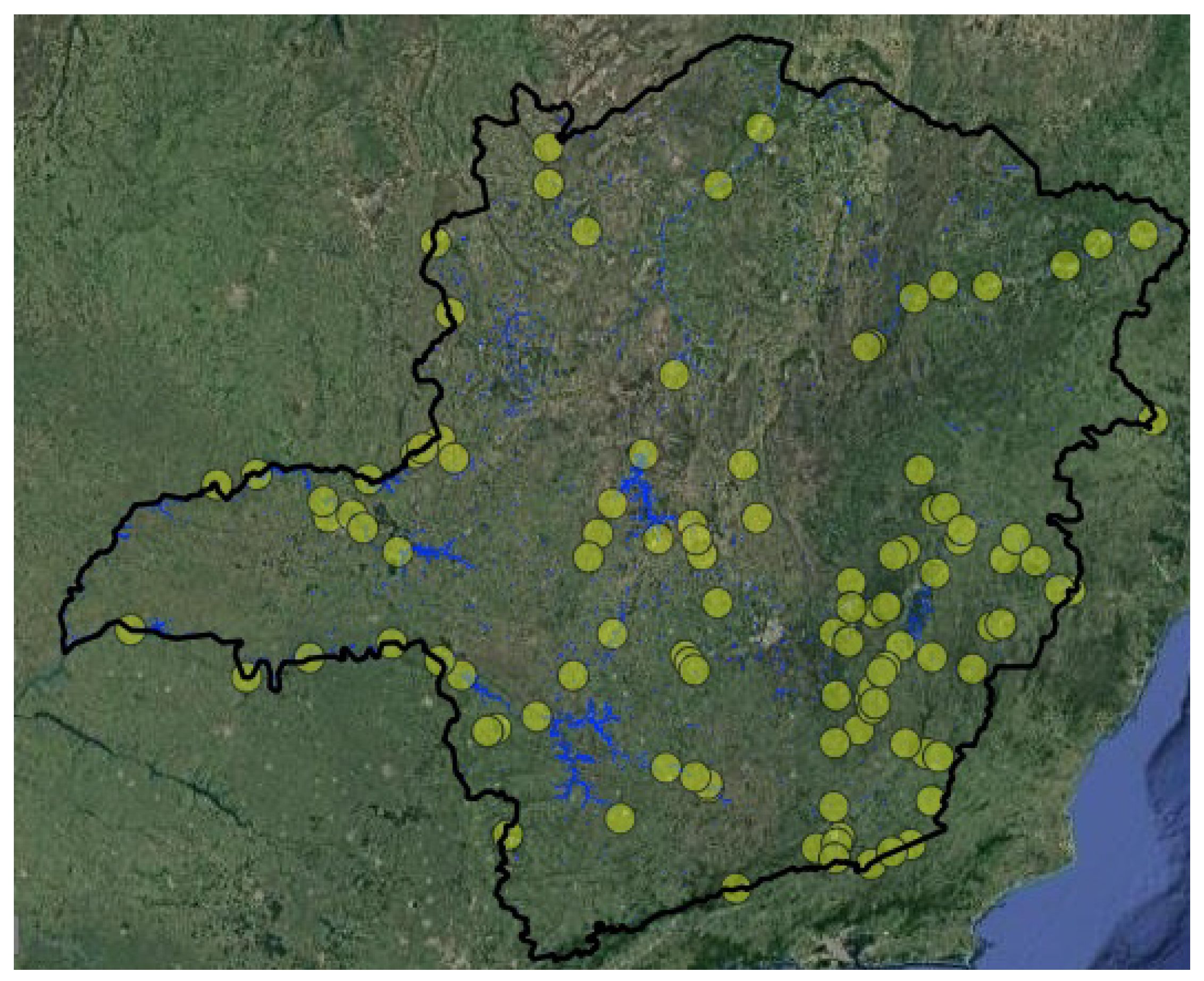
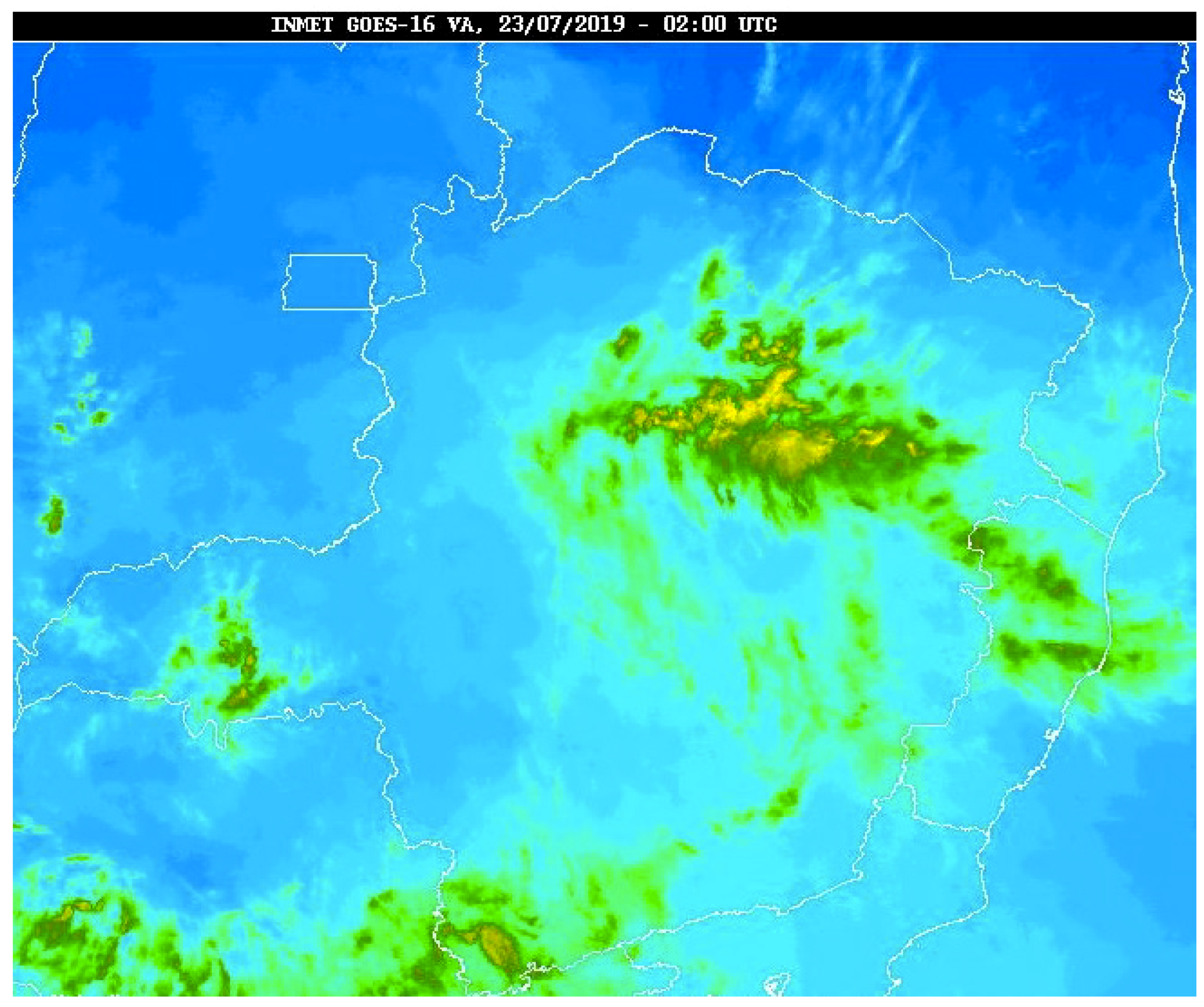
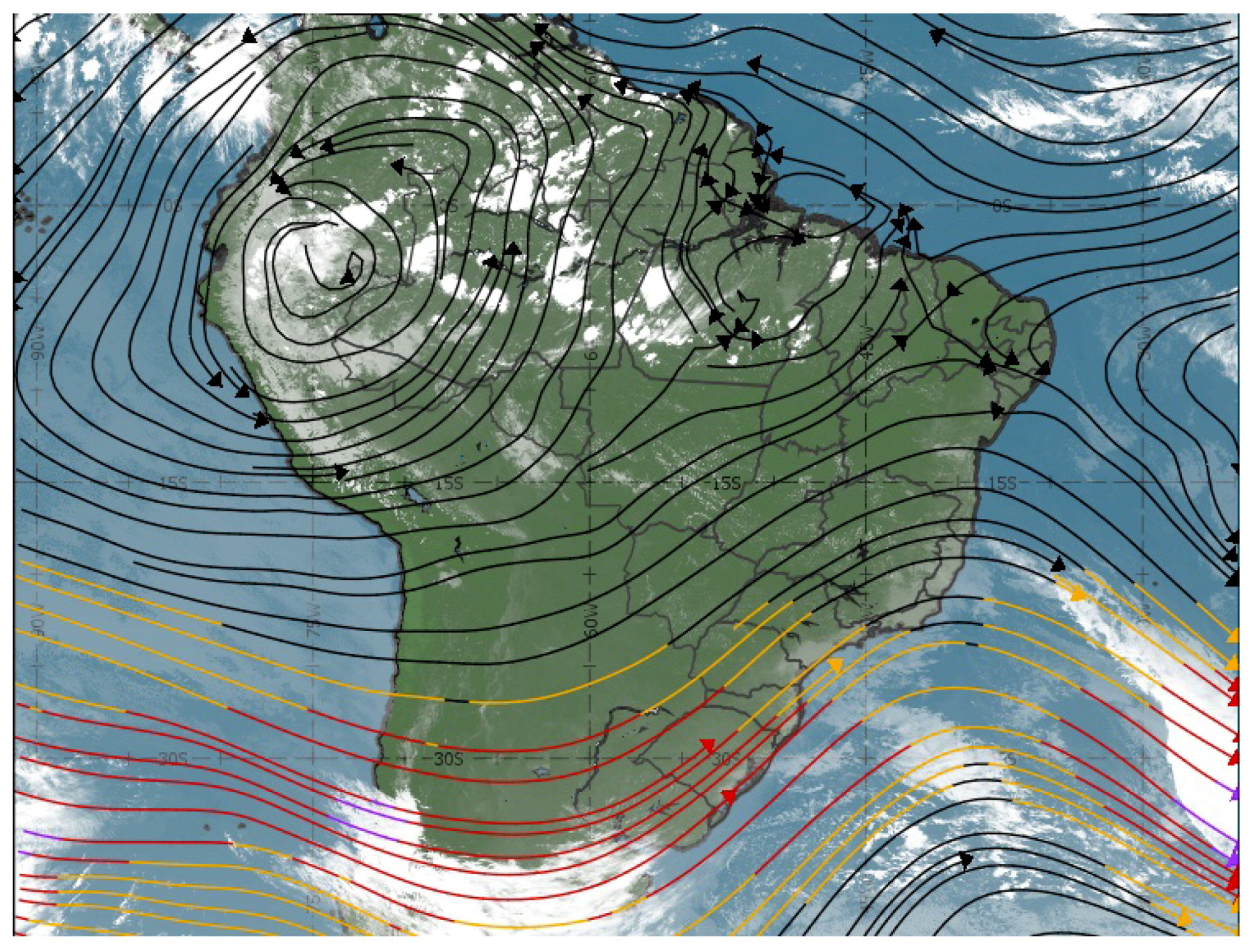
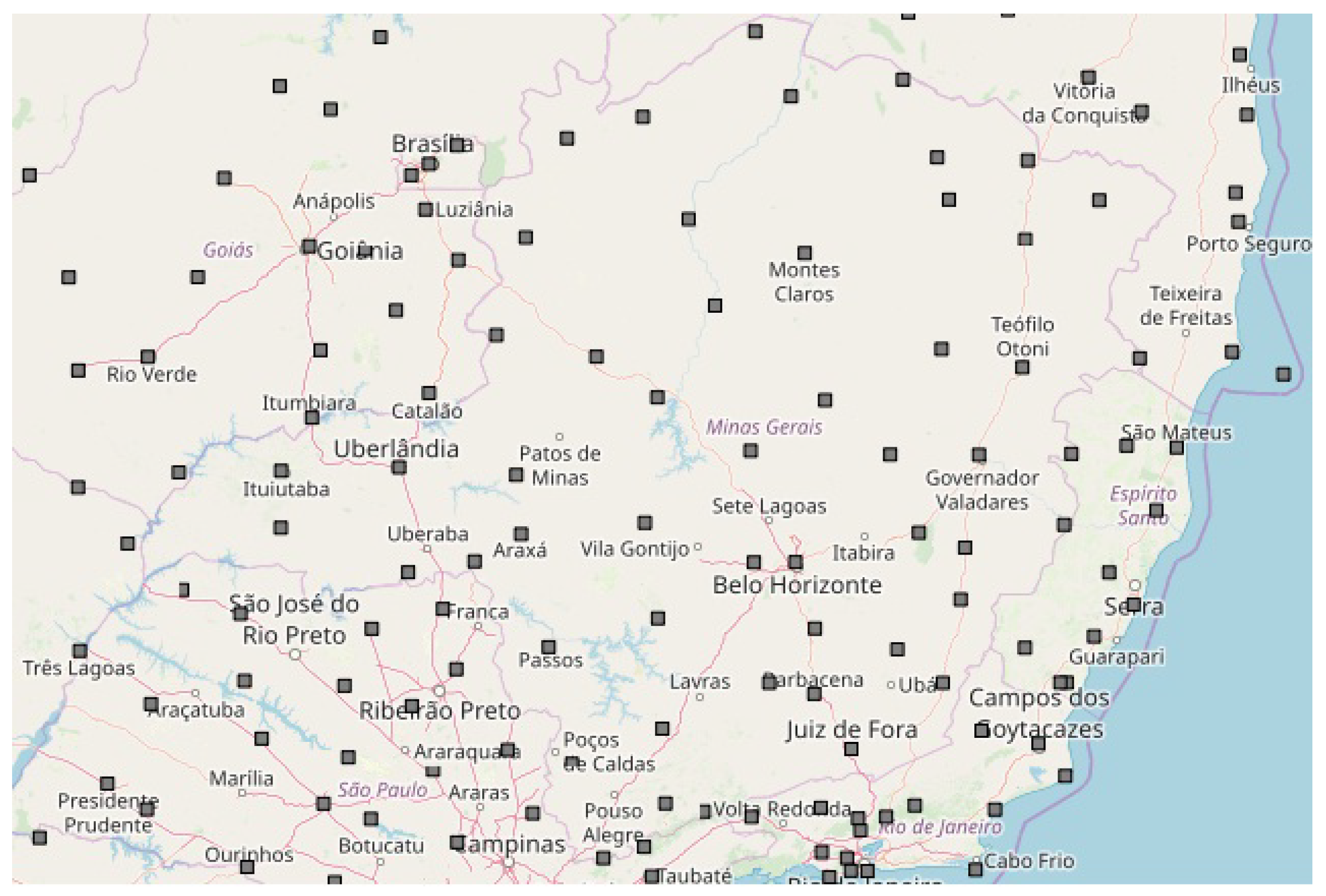
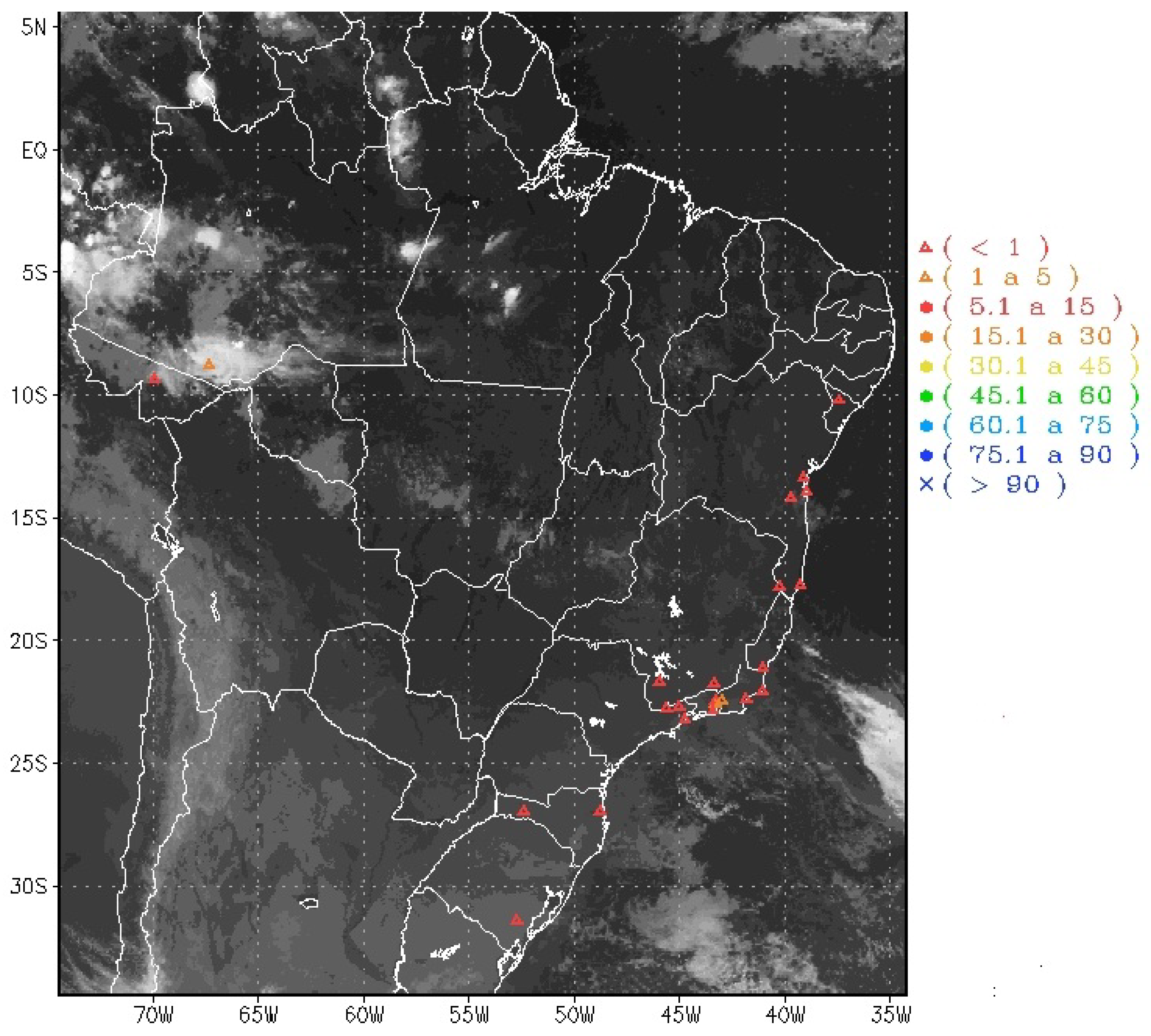
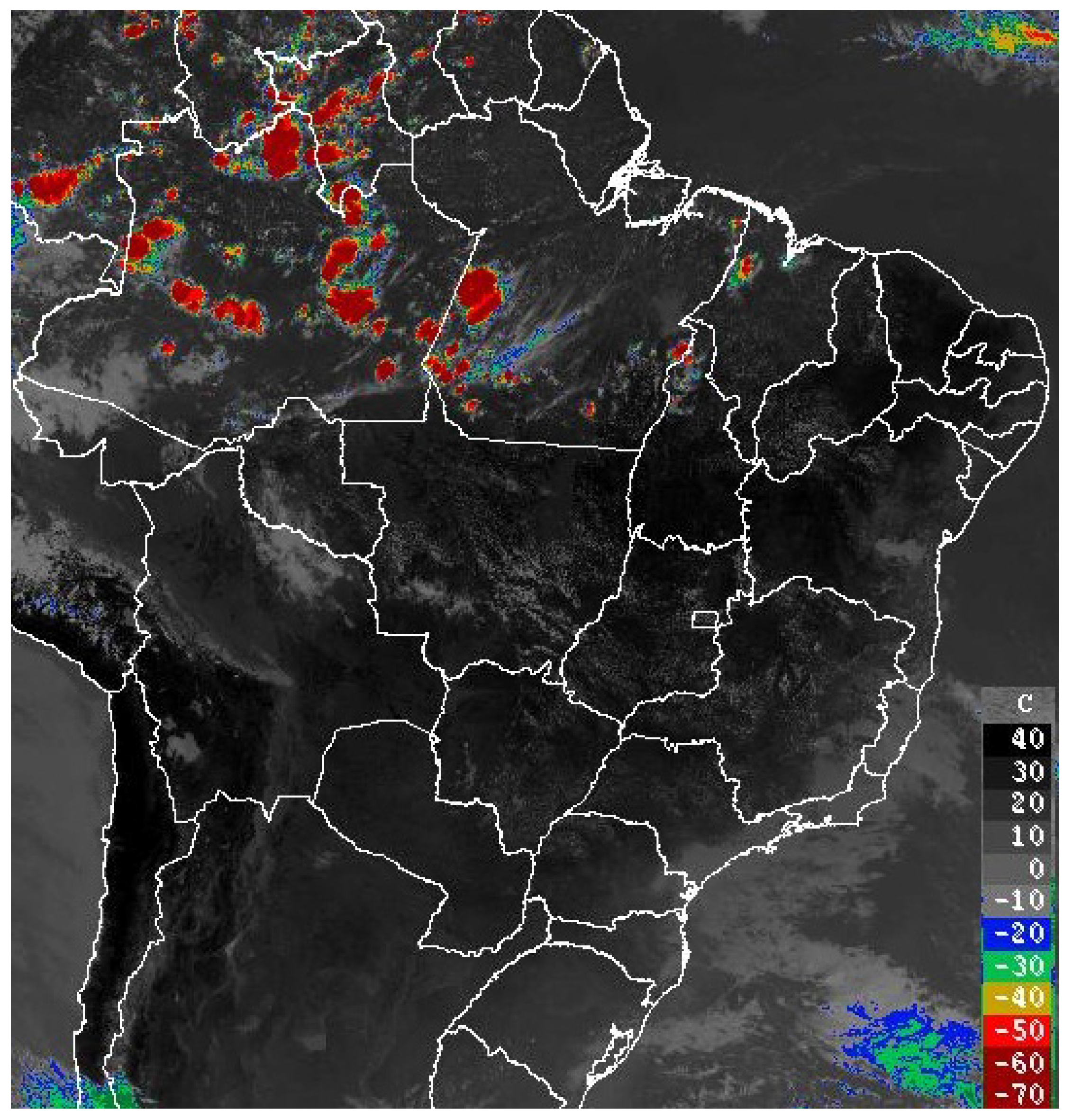
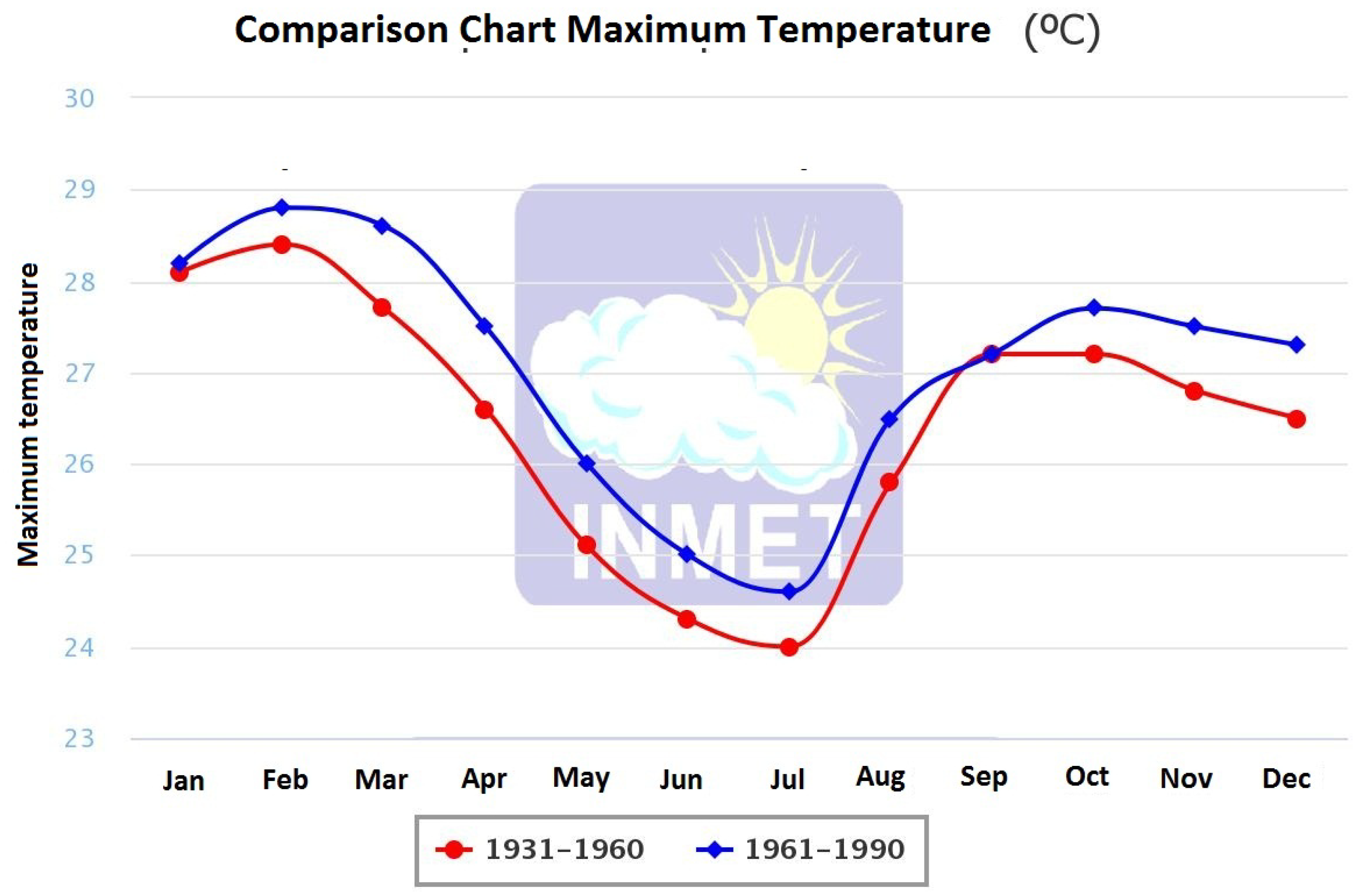

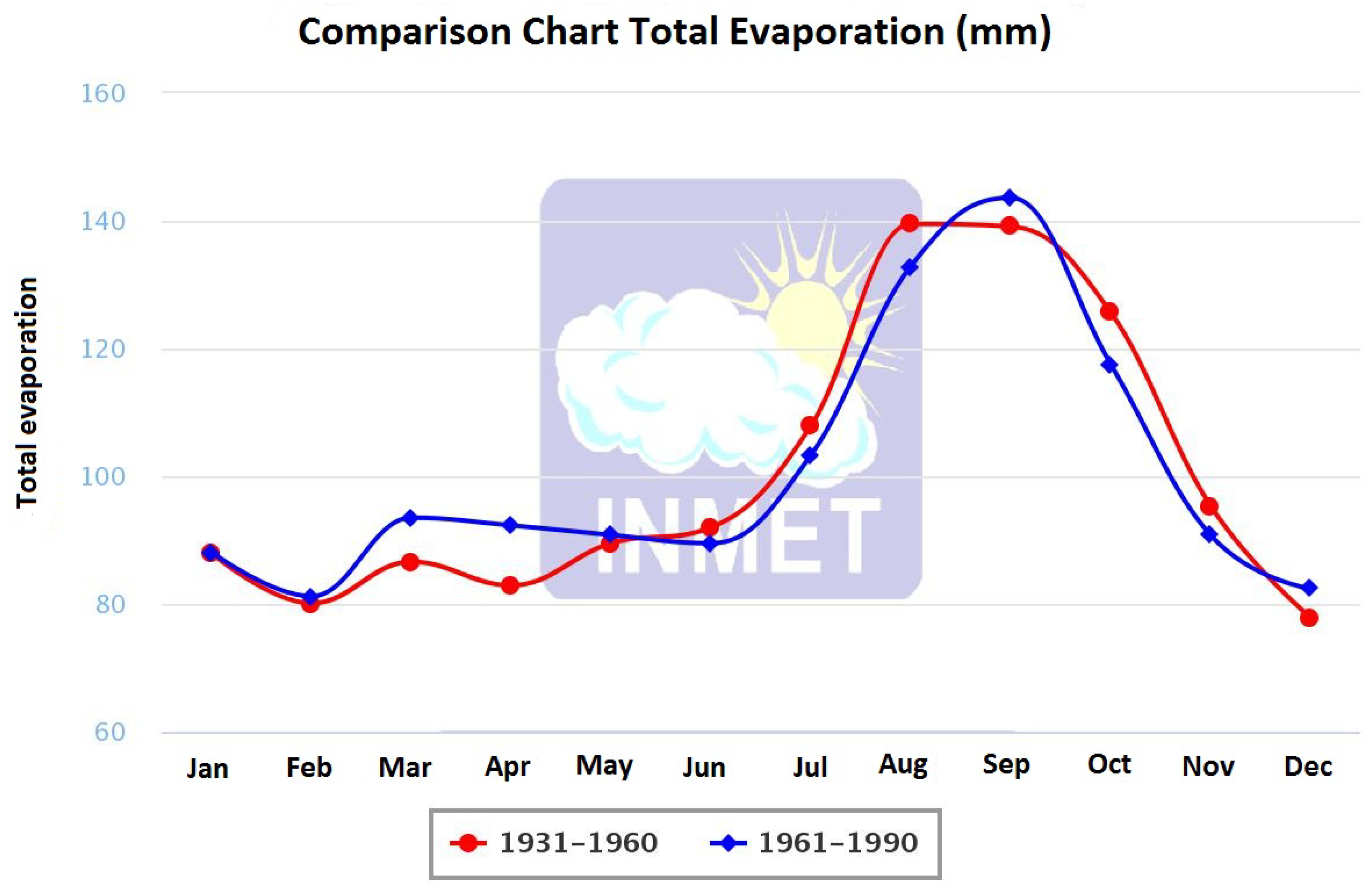
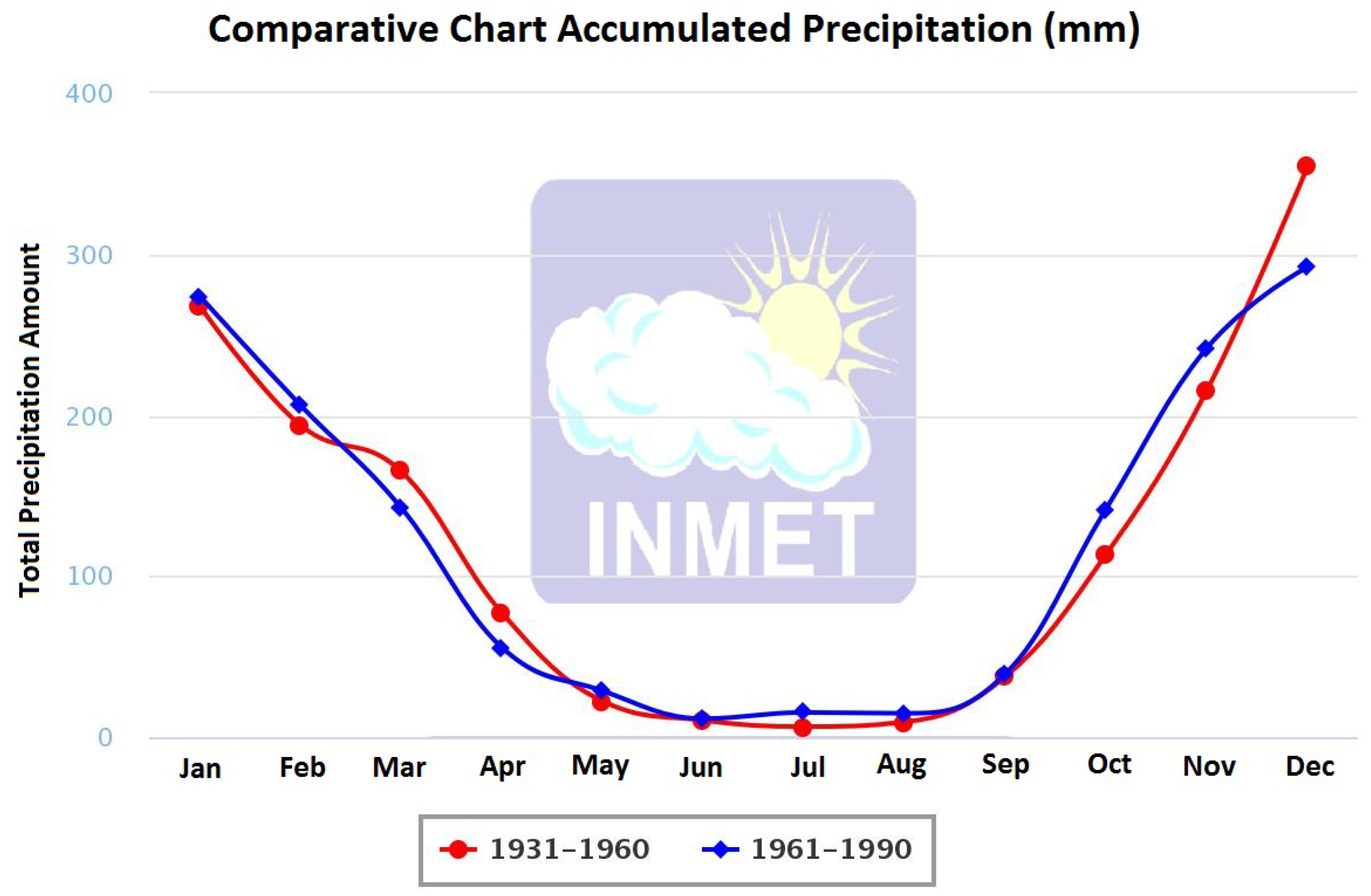
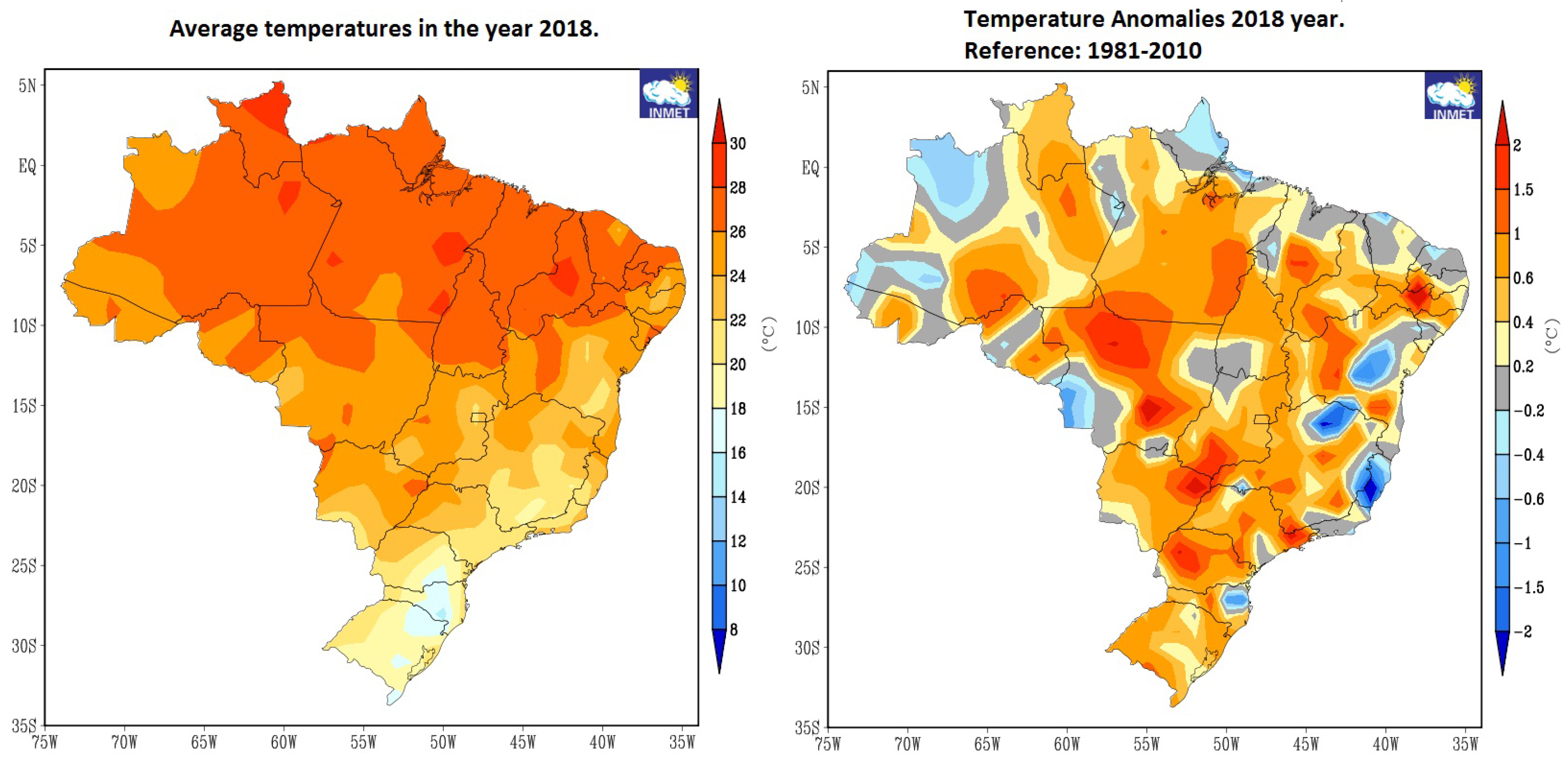
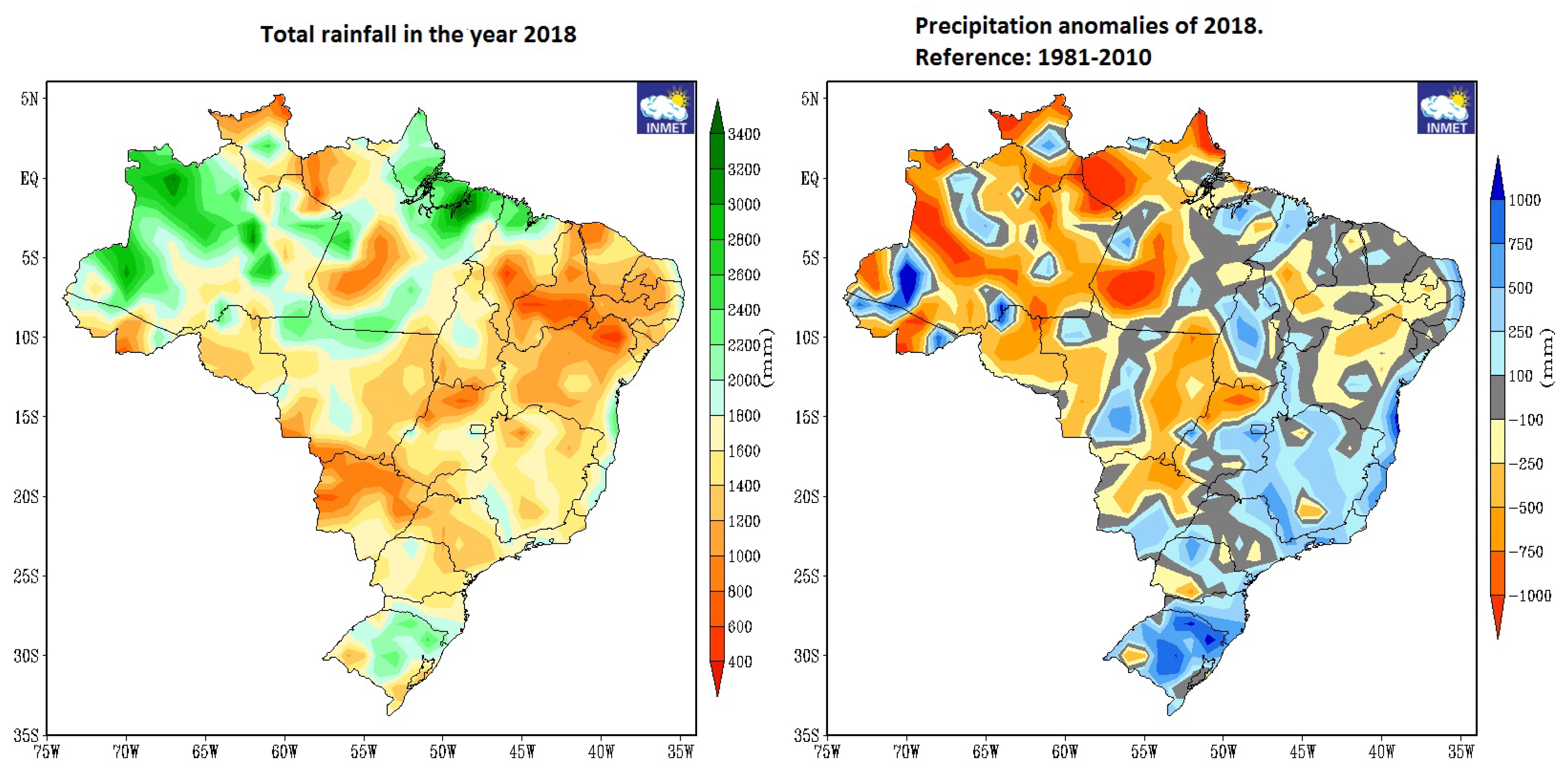
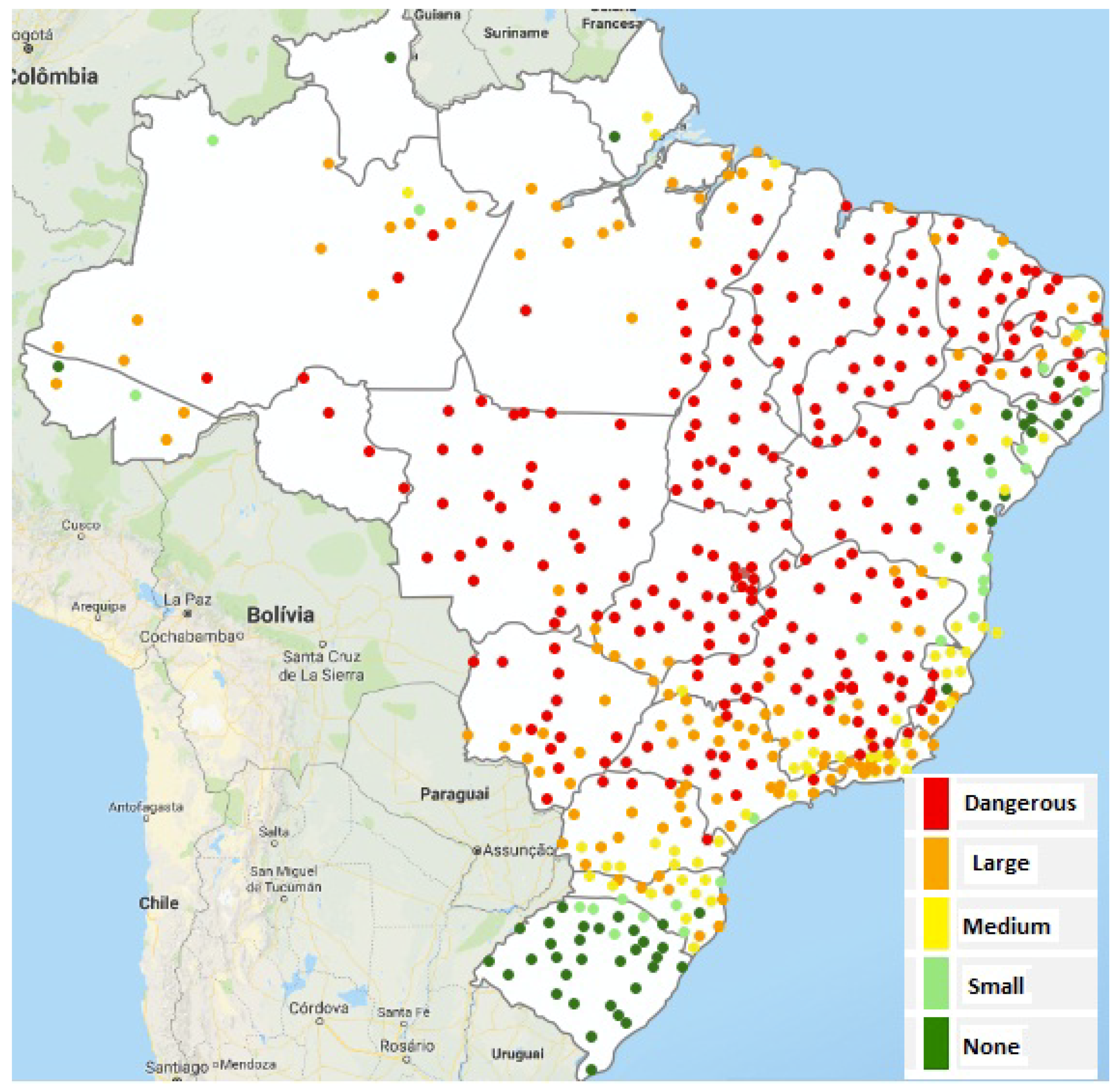
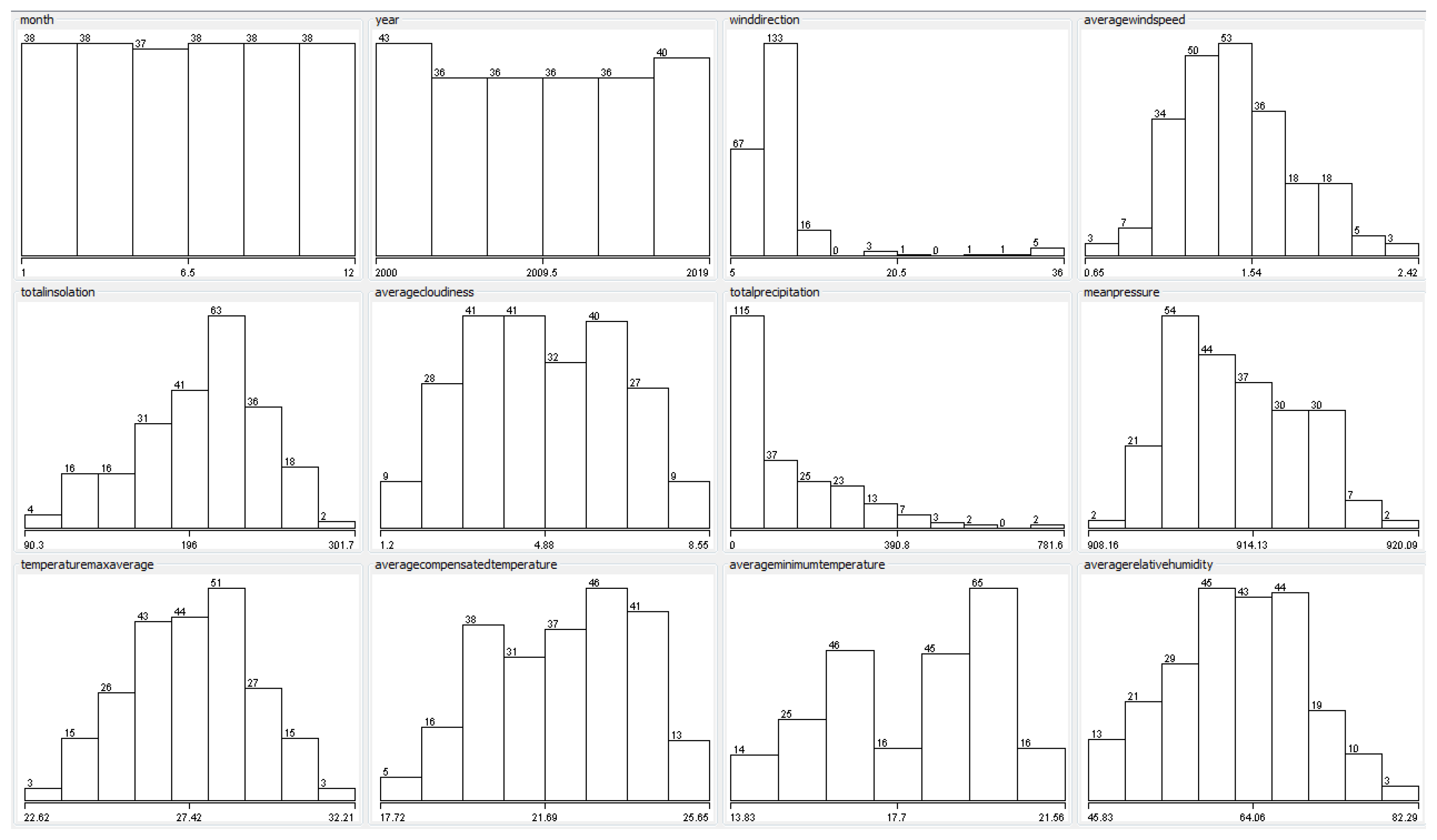
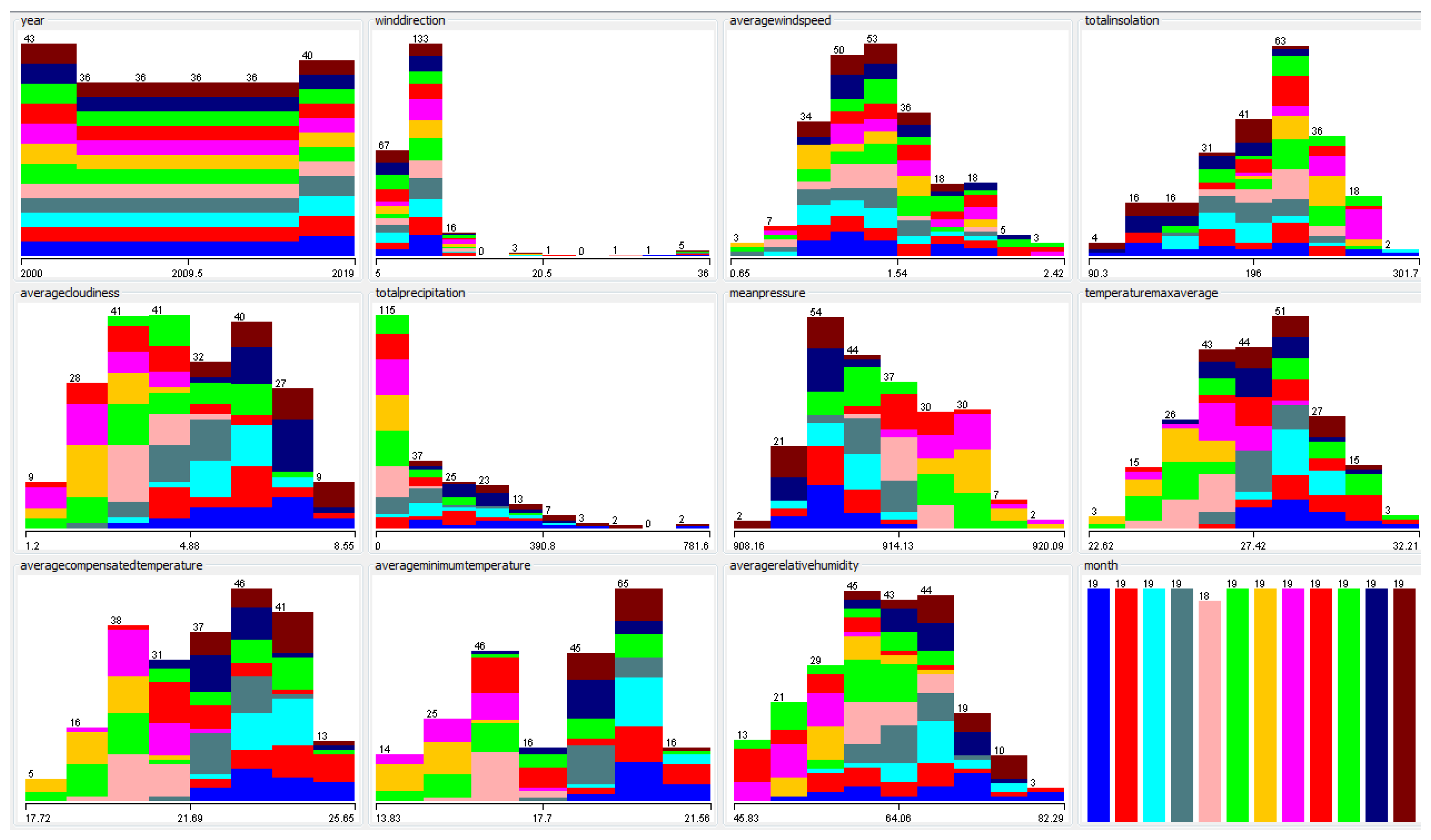
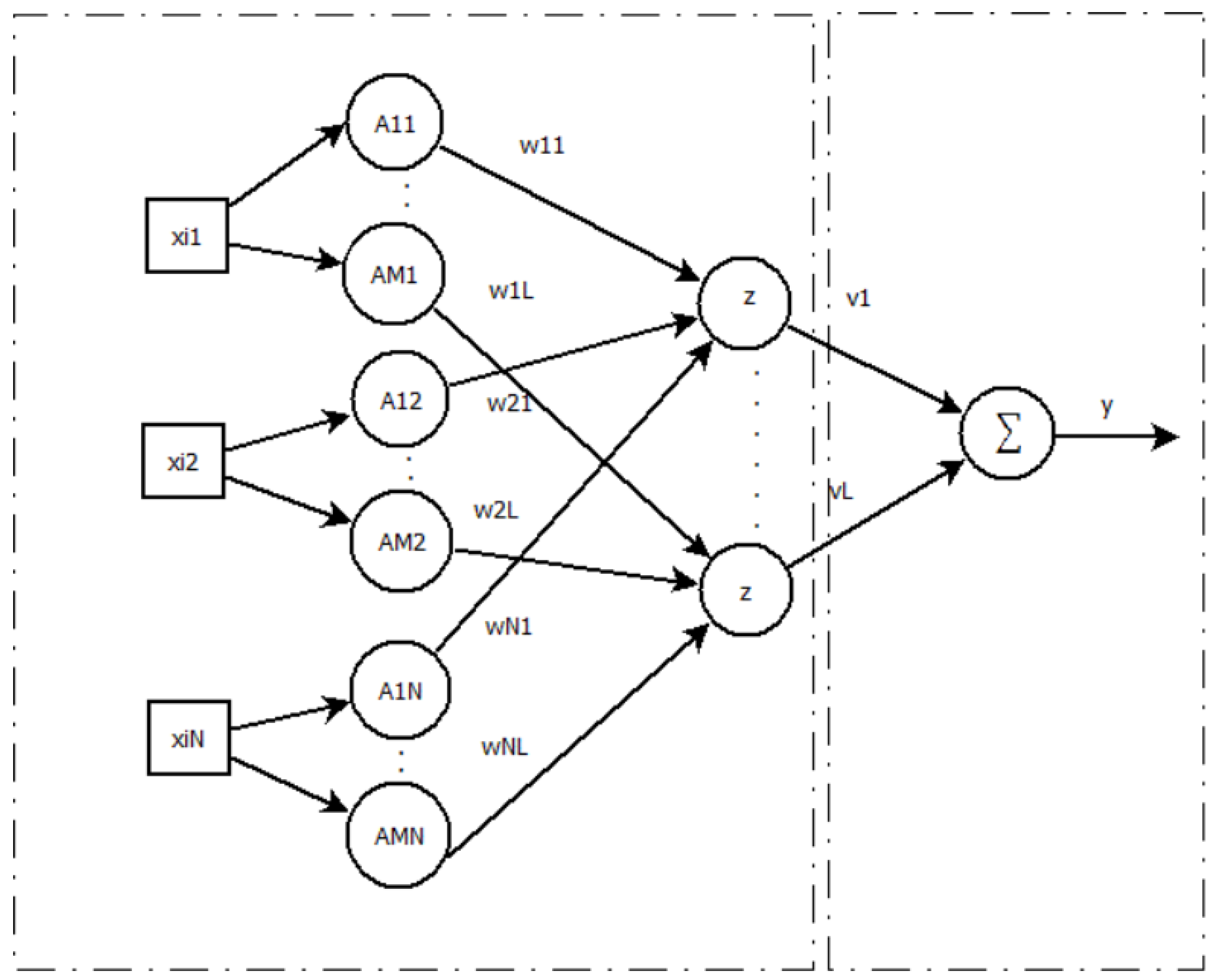
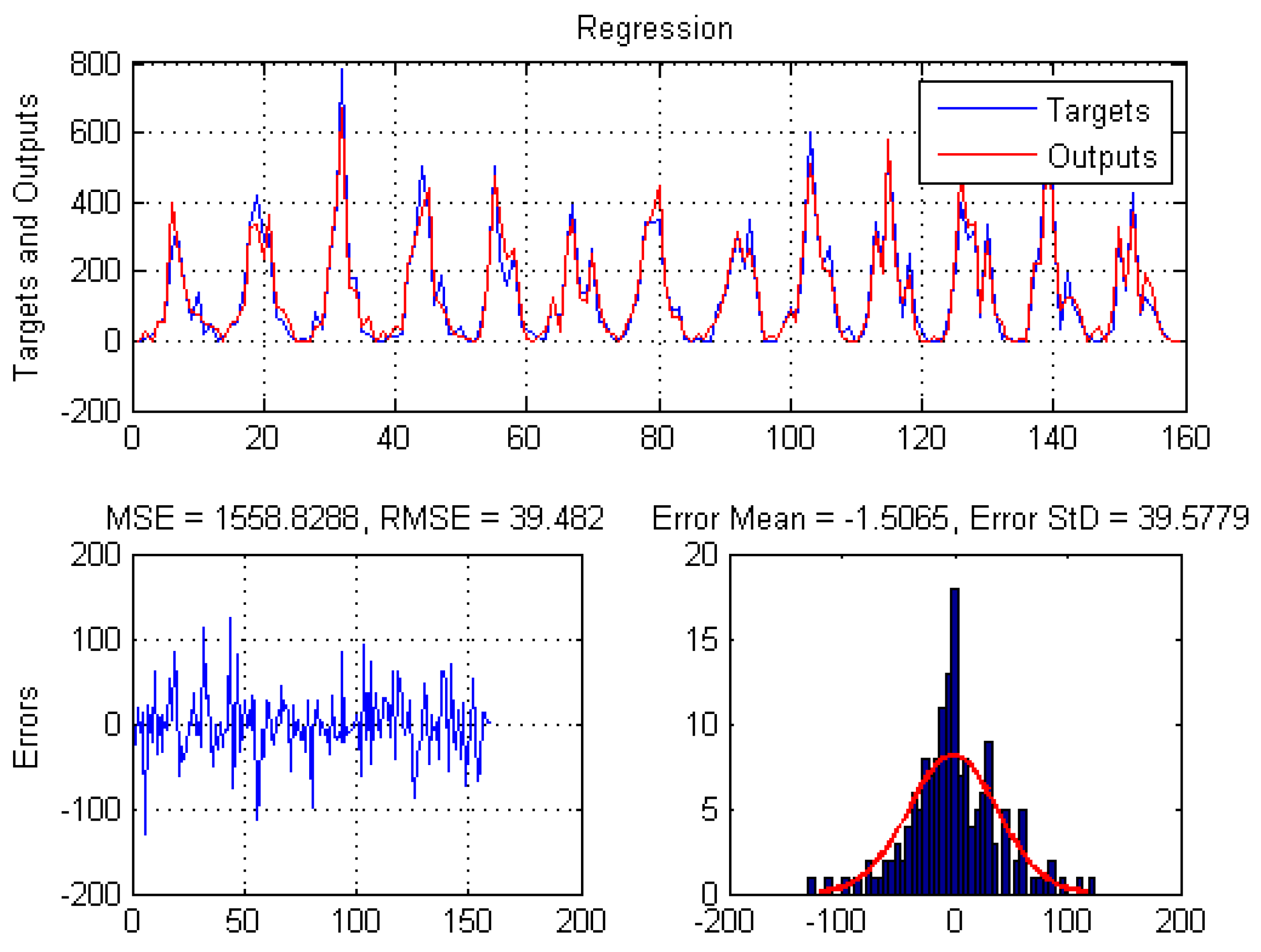
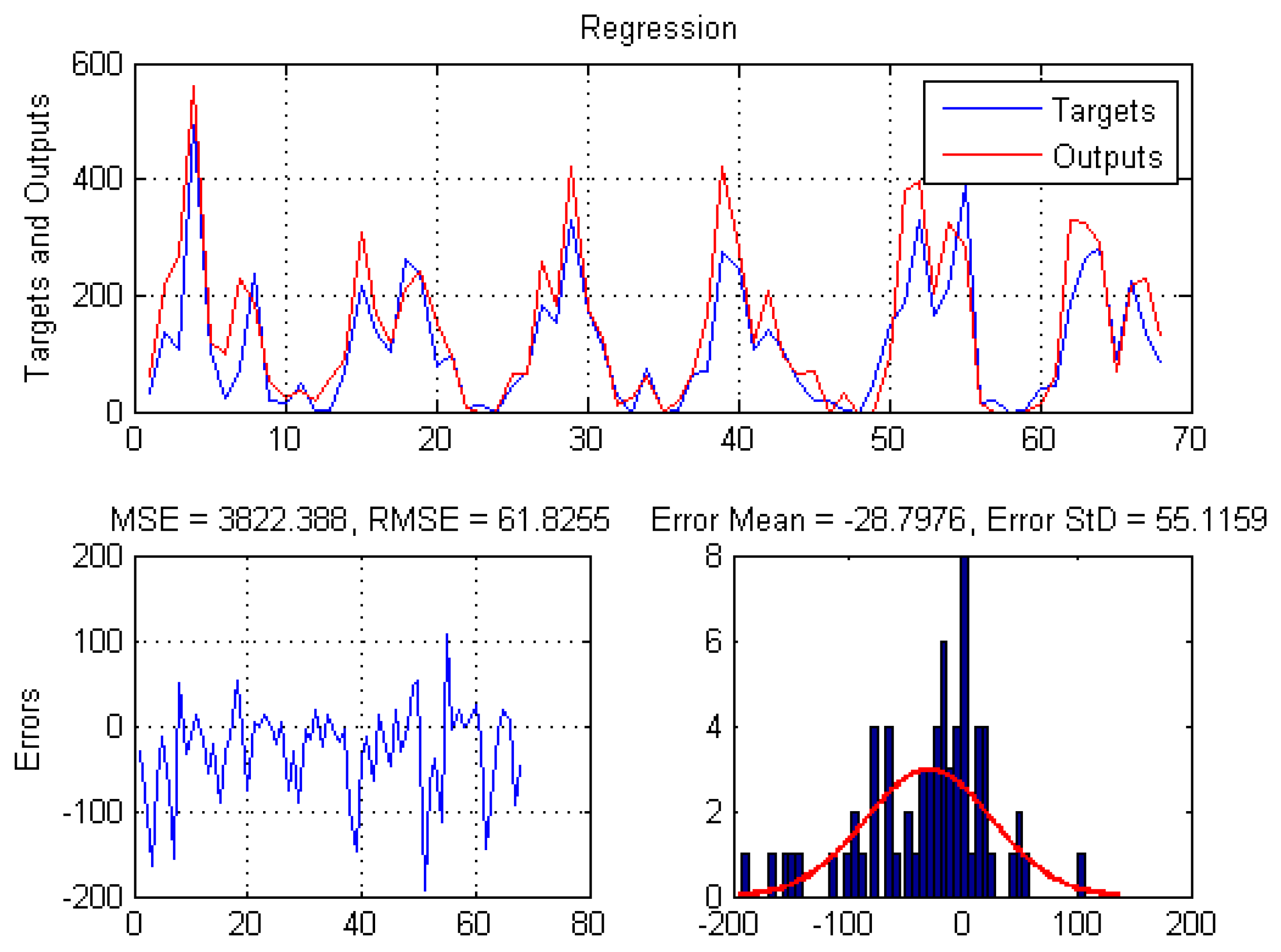
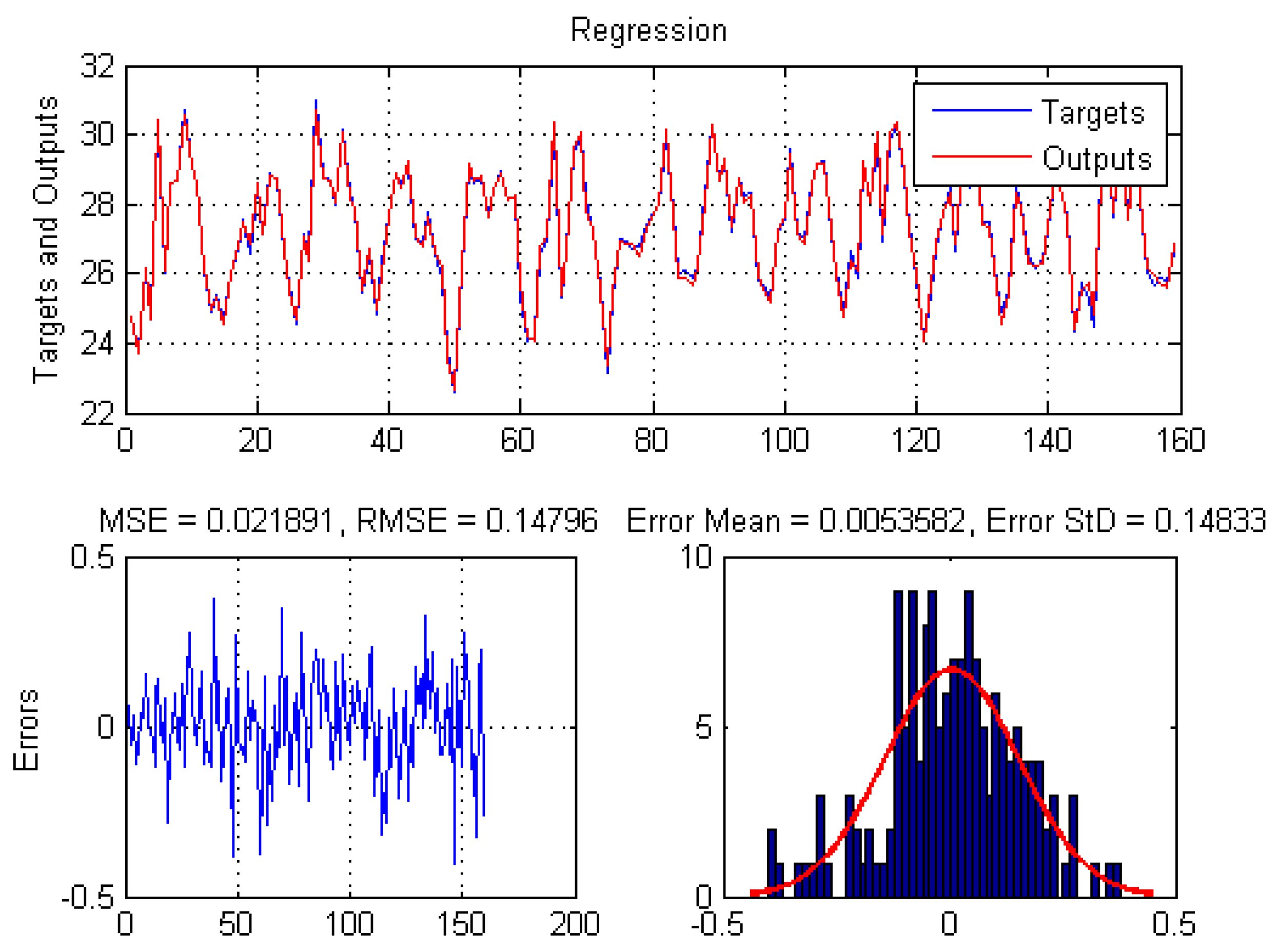
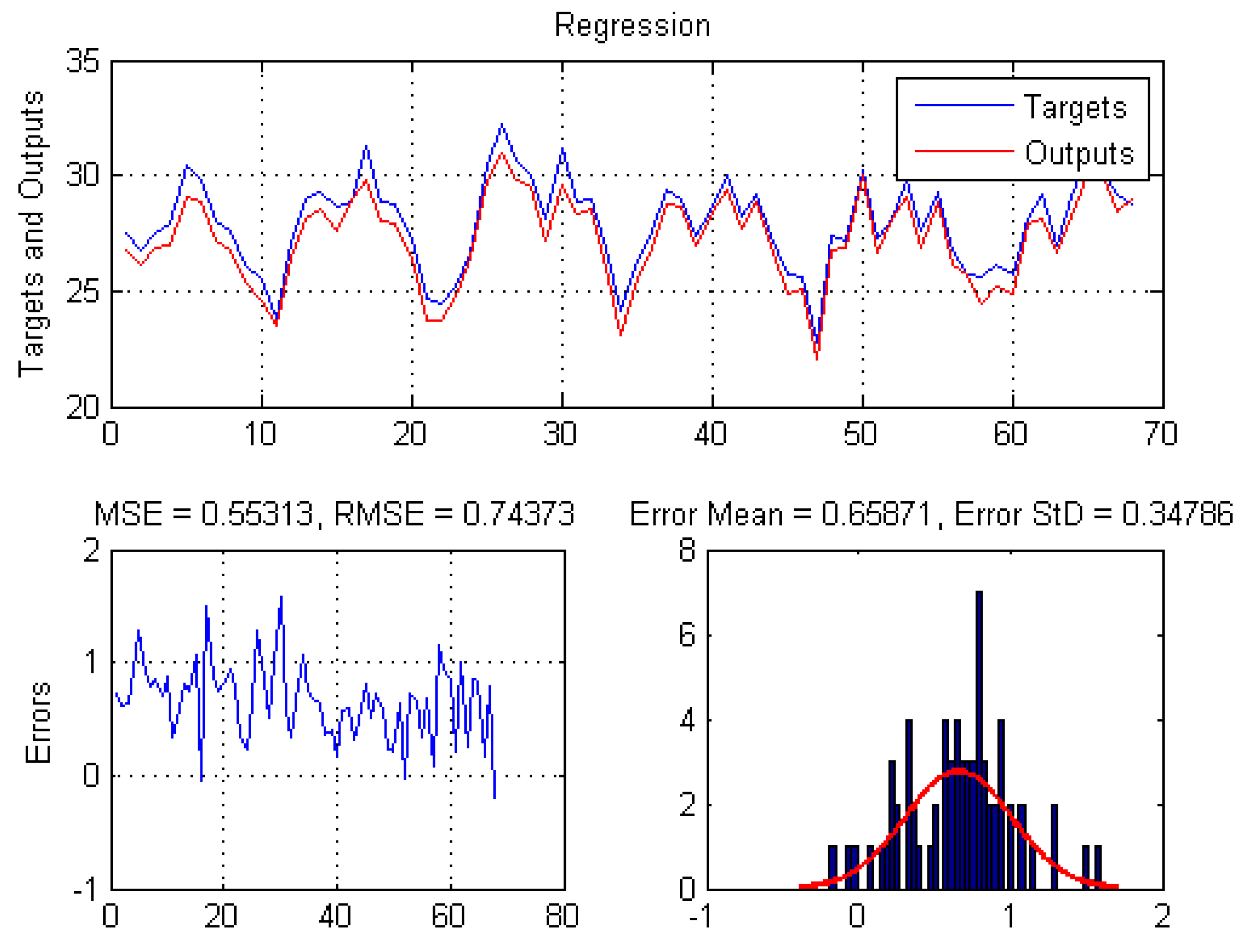
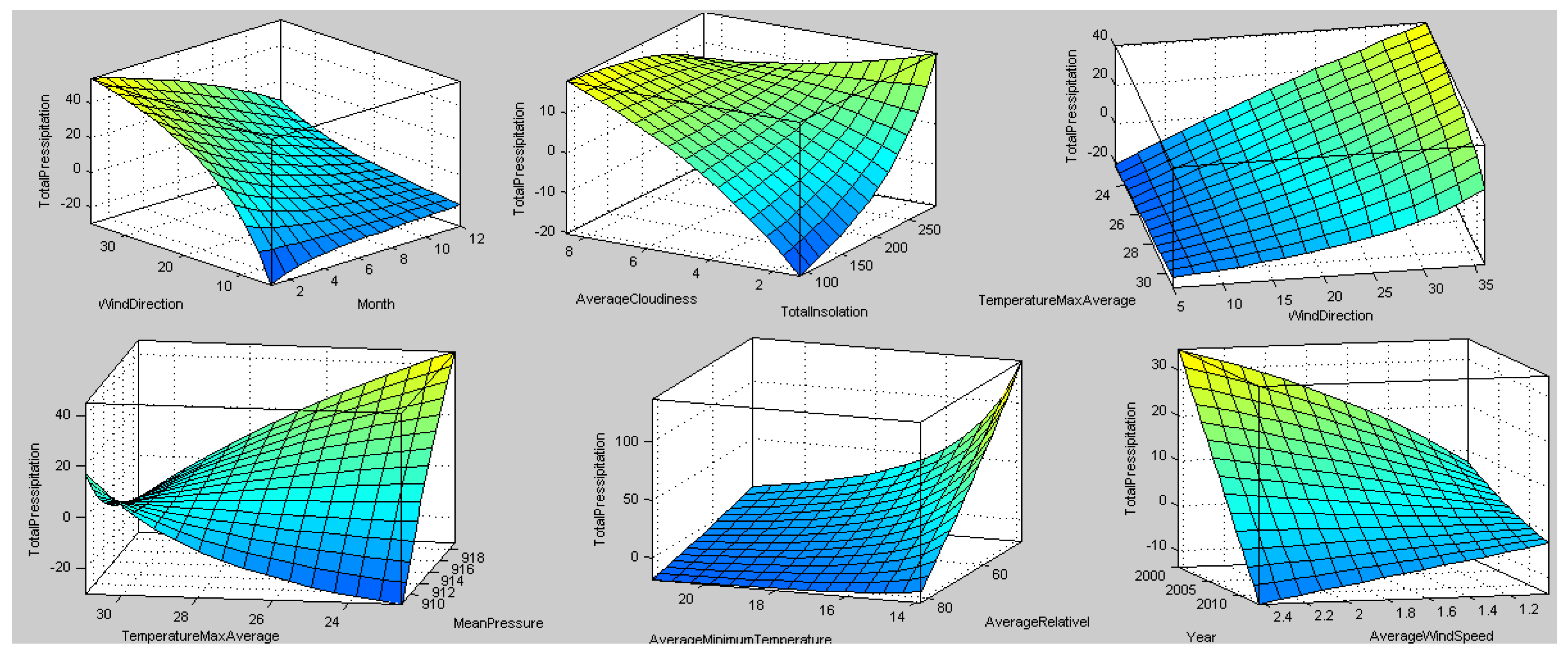
| Station: Belo Horizonte—MG (OMM: 83587) | Value |
|---|---|
| Latitude (degrees): | −19.93 |
| Longitude (degrees): | −43.93 |
| Elevation (meters): | 915.00 |
| Start of operation: | 03/03/1910 |
| Requested period of data: | 01/01/2000 to 04/01/2019 |
| Station: Belo Horizonte—MG | Range or Average |
|---|---|
| Mount | 1 to 12 |
| Year | 2000 to 2019 |
| Wind Direction | 9.128 (5.324) |
| Average Wind Speed | 1.458 (0.314) |
| Total Insolation | 202.438 (40.407) |
| Average Cloudiness | 4.862 (1.705) |
| Mean Pressure | 913.511 (2.251) |
| Mean Maximum Temperature | 27.463 (1.819) |
| Mean Compensated Temperature | 22.166 (1.784) |
| Mean Minimum Temperature | 18.138 (1.933) |
| Mean Relative Humidity | 62.429 (7.49) |
| Models | RMSE | Time | MSE |
|---|---|---|---|
| FNN | 60.45 | 47.63 | 3654.78 |
| MLP | 146.74 | 1.34 | 21,532.62 |
| LIN | 58.34 | 0.02 | 3403.53 |
| GAU | 64.51 | 0.05 | 4161.54 |
| Models | RMSE | Time | MSE |
|---|---|---|---|
| FNN | 0.74 | 46.26 | 0.55 |
| MLP | 0.50 | 1.36 | 0.25 |
| LIN | 0.71 | 0.00 | 0.50 |
| GAU | 0.56 | 0.06 | 0.36 |
© 2019 by the authors. Licensee MDPI, Basel, Switzerland. This article is an open access article distributed under the terms and conditions of the Creative Commons Attribution (CC BY) license (http://creativecommons.org/licenses/by/4.0/).
Share and Cite
de Campos Souza, P.V.; Batista de Oliveira, L.; Ferreira do Nascimento, L.A., Jr. Fuzzy Rules to Help Predict Rains and Temperatures in a Brazilian Capital State Based on Data Collected from Satellites. Appl. Sci. 2019, 9, 5476. https://doi.org/10.3390/app9245476
de Campos Souza PV, Batista de Oliveira L, Ferreira do Nascimento LA Jr. Fuzzy Rules to Help Predict Rains and Temperatures in a Brazilian Capital State Based on Data Collected from Satellites. Applied Sciences. 2019; 9(24):5476. https://doi.org/10.3390/app9245476
Chicago/Turabian Stylede Campos Souza, Paulo Vitor, Lucas Batista de Oliveira, and Luiz Antônio Ferreira do Nascimento, Jr. 2019. "Fuzzy Rules to Help Predict Rains and Temperatures in a Brazilian Capital State Based on Data Collected from Satellites" Applied Sciences 9, no. 24: 5476. https://doi.org/10.3390/app9245476
APA Stylede Campos Souza, P. V., Batista de Oliveira, L., & Ferreira do Nascimento, L. A., Jr. (2019). Fuzzy Rules to Help Predict Rains and Temperatures in a Brazilian Capital State Based on Data Collected from Satellites. Applied Sciences, 9(24), 5476. https://doi.org/10.3390/app9245476





